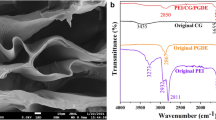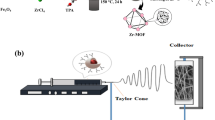Abstract
In this work, a novel and easy-separating rare earth adsorbent (PAA/PPNWF) was successfully synthesized by generating dense polyacrylic acid (PAA) on the surface of polypropylene nonwoven fabric (PPNWF) via UV-induced photograft technology. PAA/PPNWF was characterized by optical microscope (OM), Fourier transform infrared spectroscopy (FT-IR), scanning electron microscope (SEM) and X-ray photoelectron spectroscopy (XPS). Ce3+ was used as a model for investigating the adsorption performance of PAA/PPNWF. The maximum adsorption for Ce3+ reached 364.21 mg g−1 (initial concentration = 600 mg L−1, pH 6, T = 303.15 K) and the adsorption achieved equilibrium quickly within 40 min. PAA/PPNWF could be regenerated easily and there was small loss of its adsorption capacity after regeneration (keeping 86.7% adsorption capacity after even 8 times adsorption–desorption cycle). Moreover, 96% of Ce3+ was recycled efficiently from simulated wastewater with low pH and concentration within 60 min by PAA/PPNWF, which reflects application potential of this adsorbent.
Graphic Abstract







Similar content being viewed by others
References
Zhang K, Kleit AN, Nieto A (2017) An economics strategy for criticality—application to rare earth element Yttrium in new lighting technology and its sustainable availability. Renew Sustain Energy Rev 77:899–915. https://doi.org/10.1016/j.rser.2016.12.127
Smith Stegen K (2015) Heavy rare earths, permanent magnets, and renewable energies: an imminent crisis. Energy Policy 79:1–8. https://doi.org/10.1016/j.enpol.2014.12.015
Zhao H, Xia J, Yin D et al (2019) Rare earth incorporated electrode materials for advanced energy storage. Coord Chem Rev 390:32–49. https://doi.org/10.1016/j.ccr.2019.03.011
Massari S, Ruberti M (2013) Rare earth elements as critical raw materials: focus on international markets and future strategies. Resour Policy 38:36–43. https://doi.org/10.1016/j.resourpol.2012.07.001
Barros Ó, Costa L, Costa F et al (2019) Recovery of rare earth elements from wastewater towards a circular economy. Molecules. https://doi.org/10.3390/molecules24061005
Pan J, Nie T, Vaziri Hassas B et al (2020) Recovery of rare earth elements from coal fly ash by integrated physical separation and acid leaching. Chemosphere 248:126112. https://doi.org/10.1016/j.chemosphere.2020.126112
Jyothi RK, Thenepalli T, Ahn JW et al (2020) Review of rare earth elements recovery from secondary resources for clean energy technologies: grand opportunities to create wealth from waste. J Clean Prod 267:122048. https://doi.org/10.1016/j.jclepro.2020.122048
Kegl T, Košak A, Lobnik A et al (2020) Adsorption of rare earth metals from wastewater by nanomaterials: a review. J Hazard Mater 386:121632. https://doi.org/10.1016/j.jhazmat.2019.121632
Ambaye TG, Vaccari M, Castro FD et al (2020) Emerging technologies for the recovery of rare earth elements (REEs) from the end-of-life electronic wastes: a review on progress, challenges, and perspectives. Environ Sci Pollut Res 27:36052–36074. https://doi.org/10.1007/s11356-020-09630-2
Nkinahamira F, Alsbaiee A, Zeng Q et al (2020) Selective and fast recovery of rare earth elements from industrial wastewater by porous β-cyclodextrin and magnetic β-cyclodextrin polymers. Water Res 181:115857. https://doi.org/10.1016/j.watres.2020.115857
Li C, Zhuang Z, Huang F et al (2013) Recycling rare earth elements from industrial wastewater with flowerlike nano-Mg(OH)2. ACS Appl Mater Interfaces 5:9719–9725. https://doi.org/10.1021/am4027967
Tian L, Chang H, Tang P et al (2020) Rare Earth elements occurrence and economical recovery strategy from shale gas wastewater in the Sichuan Basin, China. ACS Sustain Chem Eng 8:11914–11920. https://doi.org/10.1021/acssuschemeng.0c04971
Ni S, Chen Q, Gao Y et al (2020) Recovery of rare earths from industrial wastewater using extraction-precipitation strategy for resource and environmental concerns. Miner Eng 151:106315. https://doi.org/10.1016/j.mineng.2020.106315
Felipe ECB, Batista KA, Ladeira ACQ (2020) Recovery of rare earth elements from acid mine drainage by ion exchange. Environ Technol (United Kingdom) 0:1–32. https://doi.org/10.1080/09593330.2020.1713219
Zhou Y, Schulz S, Lindoy LF et al (2020) Separation and recovery of rare earths by in situ selective electrochemical oxidation and extraction from spent fluid catalytic cracking (FCC) catalysts. Hydrometallurgy 194:105300. https://doi.org/10.1016/j.hydromet.2020.105300
Ni’am AC, Wang YF, Chen SW et al (2020) Simultaneous recovery of rare earth elements from waste permanent magnets (WPMs) leach liquor by solvent extraction and hollow fiber supported liquid membrane. Chem Eng Process Process Intensif 148:107831. https://doi.org/10.1016/j.cep.2020.107831
Guo Z, Li Q, Li Z et al (2020) Fabrication of efficient alginate composite beads embedded with N-doped carbon dots and their application for enhanced rare earth elements adsorption from aqueous solutions. J Colloid Interface Sci 562:224–234. https://doi.org/10.1016/j.jcis.2019.12.030
Javadian H, Ruiz M, Saleh TA, Sastre AM (2020) Ca-alginate/carboxymethyl chitosan/Ni0.2Zn0.2Fe2.6O4 magnetic bionanocomposite: synthesis, characterization and application for single adsorption of Nd3+, Tb3+, and Dy3+ rare earth elements from aqueous media. J Mol Liq. https://doi.org/10.1016/j.molliq.2020.112760
Zhu Y, Wang W, Zheng Y et al (2016) Rapid enrichment of rare-earth metals by carboxymethyl cellulose-based open-cellular hydrogel adsorbent from HIPEs template. Carbohydr Polym 140:51–58. https://doi.org/10.1016/j.carbpol.2015.12.003
Royer-Lavallée A, Neculita CM, Coudert L (2020) Removal and potential recovery of rare earth elements from mine water. J Ind Eng Chem 89:47–57. https://doi.org/10.1016/j.jiec.2020.06.010
Stragliotto MF, Strumia MC, Gomez CG, Romero MR (2018) Optimization of UV-induced graft polymerization of acrylic acid on polypropylene films using CdS as light sensor. Ind Eng Chem Res 57:1188–1196. https://doi.org/10.1021/acs.iecr.7b04526
Zhao J, Shi Q, Luan S et al (2011) Improved biocompatibility and antifouling property of polypropylene non-woven fabric membrane by surface grafting zwitterionic polymer. J Membr Sci 369:5–12. https://doi.org/10.1016/j.memsci.2010.10.046
Barbey R, Lavanant L, Paripovic D et al (2009) Polymer brushes via surface-initiated controlled radical polymerization: synthesis, characterization, properties, and applications. Chem Rev 109:5437
Li XJ, Yan CJ, Luo WJ et al (2016) Exceptional cerium(III) adsorption performance of poly(acrylic acid) brushes-decorated attapulgite with abundant and highly accessible binding sites. Chem Eng J 284:333–342. https://doi.org/10.1016/j.cej.2015.09.003
Černáková L, Kováčik D, Zahoranová A et al (2005) Surface modification of polypropylene non-woven fabrics by atmospheric-pressure plasma activation followed by acrylic acid grafting. Plasma Chem Plasma Process 25:427–437. https://doi.org/10.1007/s11090-004-3137-4
Barsbay M, Güven O (2013) RAFT mediated grafting of poly(acrylic acid) (PAA) from polyethylene/polypropylene (PE/PP) nonwoven fabric via preirradiation. Polymer (Guildf) 54:4838–4848. https://doi.org/10.1016/j.polymer.2013.06.059
Hegemann D, Brunner H, Oehr C (2003) Plasma treatment of polymers for surface and adhesion improvement. Nucl Instrum Methods Phys Res Sect B Beam Interact Mater Atoms 208:281–286. https://doi.org/10.1016/S0168-583X(03)00644-X
Stache EE, Kottisch V, Fors BP (2020) Photocontrolled radical polymerization from hydridic C–H bonds. J Am Chem Soc 142:4581–4585. https://doi.org/10.1021/jacs.0c00287
Roppolo I, Chiappone A, Bejtka K et al (2014) A powerful tool for graphene functionalization: benzophenone mediated UV-grafting. Carbon NY 77:226–235. https://doi.org/10.1016/j.carbon.2014.05.025
Gao S, Luo T, Zhou Q, Luo W (2018) A novel and efficient method on the recovery of nanosized CeO2 in Ce3+ wastewater remediation using modified sawdust as adsorbent. J Colloid Interface Sci 512:629–637. https://doi.org/10.1016/j.jcis.2017.09.032
Zhou Q, Yang H, Yan C et al (2016) Synthesis of carboxylic acid functionalized diatomite with a micro-villous surface via UV-induced graft polymerization and its adsorption properties for Lanthanum(III) ions. Colloids Surf A Physicochem Eng Asp 501:9–16. https://doi.org/10.1016/j.colsurfa.2016.04.030
Guo X, Wang J (2019) A general kinetic model for adsorption: theoretical analysis and modeling. J Mol Liq 288:111100. https://doi.org/10.1016/j.molliq.2019.111100
Al-Ghouti MA, Da’ana DA (2020) Guidelines for the use and interpretation of adsorption isotherm models: a review. J Hazard Mater 393:122383. https://doi.org/10.1016/j.jhazmat.2020.122383
Tran HN, You SJ, Hosseini-Bandegharaei A, Chao HP (2017) Mistakes and inconsistencies regarding adsorption of contaminants from aqueous solutions: a critical review. Water Res 120:88–116. https://doi.org/10.1016/j.watres.2017.04.014
Kissin YV, Tsvetkova VI, Chirkov NM (1972) The stereoregularity of polypropylene from IR and NMR data. Eur Polym J 8:529–546
Pavia DL, Lampman GM, Kriz GS, Vyvyan JA (2014) Introduction to spectroscopy. Nelson Education, Toronto
Rui W, Wenqing W, Fanghe W et al (2020) Construction of nano-multilayer coatings on copolyester fabrics using UV-grafting mediated layer-by-layer self-assembly for improved anti-droplet and flame retardent performance. Polym Degrad Stab. https://doi.org/10.1016/j.polymdegradstab.2020.109405
Wang H, Liu M, Guo S et al (2017) Efficient oxidation of o-xylene over CeO2 catalyst prepared from a Ce-MOF template: the promotion of K+ embedding substitution. Mol Catal 436:120–127. https://doi.org/10.1016/j.mcat.2017.04.017
Moulder JF, Chastain J, King RC (1963) Handbook of X-ray photoelectron spectroscopy: a reference book of standard spectra for identification and interpretation of XPS data. Chem Phys Lett 99:7–10
Song T, Luo W, Mu J et al (2019) Preparation of polyacrylic-acid/palygorskite composite particles via inverse-suspension polymerization for efficient separation of Ce3+ from aqueous solution. J Colloid Interface Sci 535:371–379. https://doi.org/10.1016/j.jcis.2018.09.103
Ho Y-S, McKay G (1999) Pseudo-second order model for sorption processes. Process Biochem 34:451–465
Pereao O, Laatikainen K, Bode-Aluko C et al (2020) Adsorption of Ce3+ and Nd3+ by diglycolic acid functionalised electrospun polystyrene nanofiber from aqueous solution. Sep Purif Technol 233:116059. https://doi.org/10.1016/j.seppur.2019.116059
Doke KM, Khan EM (2013) Adsorption thermodynamics to clean up wastewater; critical review. Rev Environ Sci Biotechnol 12:25–44. https://doi.org/10.1007/s11157-012-9273-z
Tran HN, Lin CC, Woo SH, Chao HP (2018) Efficient removal of copper and lead by Mg/Al layered double hydroxides intercalated with organic acid anions: adsorption kinetics, isotherms, and thermodynamics. Appl Clay Sci 154:17–27. https://doi.org/10.1016/j.clay.2017.12.033
Li Y, Fan S, Zhou Q (2019) Synthesis of carboxyl-rich biosorbent by UV-induced graft polymerization method for high efficiency adsorption of Ce3+ from aqueous solution: activation and adsorption mechanism. J Polym Environ 27:2259–2266. https://doi.org/10.1007/s10924-019-01515-x
Huang F, Zheng Y, Yang Y (2007) Study on macromolecular metal complexes: synthesis, characterization, and fluorescence properties of stoichiometric complexes for rare earth coordinated with poly(acrylic acid). J Appl Polym Sci 103:351–357. https://doi.org/10.1002/app.24421
Pajtášová M, Ondrušová D, Jóna E et al (2010) Spectral and thermal characteristics of copper(II) carboxylates with fatty acid chains and their benzothiazole adducts. J Therm Anal Calorim 100:769–777. https://doi.org/10.1007/s10973-010-0769-x
Zhao L, Azhar MR, Li X et al (2019) Adsorption of cerium (III) by HKUST-1 metal–organic framework from aqueous solution. J Colloid Interface Sci 542:421–428. https://doi.org/10.1016/j.jcis.2019.01.117
Bai B, Zhang Z, Zhao X (2020) Enhanced adsorption of rare Earth elements by a poly(itaconic acid)/magnetite sepiolite composite. Anal Lett 0:1–19. https://doi.org/10.1080/00032719.2020.1828907
Sheha RR, Mekawy ZA, Someda HH et al (2020) Assessing the sorptive ability of synthesized graphene oxide-metal oxide composite to remove certain lanthanides. Clean Soil Air Water 2000348:1–13. https://doi.org/10.1002/clen.202000348
Rahman ML, Sarjadi MS, Arshad SE et al (2019) Kenaf cellulose-based poly(amidoxime) ligand for adsorption of rare earth ions. Rare Met 38:259–269. https://doi.org/10.1007/s12598-018-1061-7
Behdani FN, Rafsanjani AT, Torab-Mostaedi M, Mohammadpour SMAK (2013) Adsorption ability of oxidized multiwalled carbon nanotubes towards aqueous Ce(III) and Sm(III). Korean J Chem Eng 30:448–455. https://doi.org/10.1007/s11814-012-0126-9
Zhu Y, Zheng Y, Wang A (2015) Preparation of granular hydrogel composite by the redox couple for efficient and fast adsorption of La (III) and Ce (III). J Environ Chem Eng 3:1416–1425
Zhou Q, Yan C, Luo W (2016) Preparation of a novel carboxylate-rich wheat straw through surface graft modification for efficient separation of Ce(III) from wastewater. Mater Des 97:195–203. https://doi.org/10.1016/j.matdes.2016.02.081
Acknowledgements
The authors acknowledge precious support provided by the National Natural Science Fund of ‘Study on the Control of Catalytic Ozonation and Bromate Formation by Surface Performance Regulation of Fe-Co/Mn Based Catalysts (No. 2018033022)’, and the fund of ‘Study on Preparation and Performance of Biomass Macromolecular Composites (No. 2017036019)’.
Author information
Authors and Affiliations
Corresponding author
Ethics declarations
Conflict of interest
We declare that we have no financial and personal relationships with other people or organizations that can inappropriately influence our work, there is no professional or other personal interest of any nature or kind in any product, service and/or company that could be construed as influencing the position presented in, or the review of, the manuscript entitled, “Dense polyacrylic acid array-immobilized polypropylene non-woven fabrics prepared via UV-induced photograft technique for the recovery of rare earth ions from aqueous solution”.
Additional information
Publisher's Note
Springer Nature remains neutral with regard to jurisdictional claims in published maps and institutional affiliations.
Supplementary Information
Below is the link to the electronic supplementary material.
Rights and permissions
About this article
Cite this article
Wei, J., Xiao, Y., Yang, C. et al. Dense Polyacrylic Acid-Immobilized Polypropylene Non-woven Fabrics Prepared Via UV-Induced Photograft Technique for the Recovery of Rare Earth Ions from Aqueous Solution. J Polym Environ 29, 2492–2503 (2021). https://doi.org/10.1007/s10924-021-02068-8
Accepted:
Published:
Issue Date:
DOI: https://doi.org/10.1007/s10924-021-02068-8




